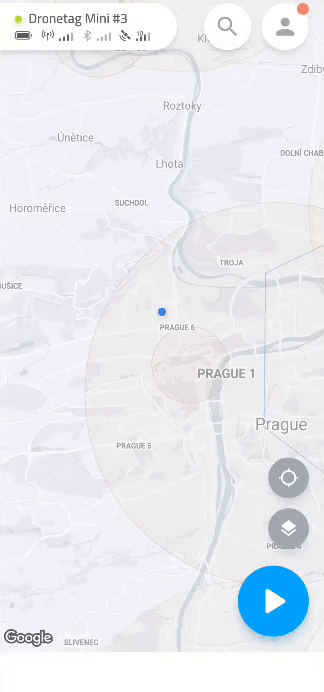Configuration
The Mini is a highly customizable piece of hardware to suit your flight's needs. It allows you to configure various device parameters, which will help you optimize the performance and battery usage. Configuration is manageable in the Mobile app via Bluetooth. Do not change the parameters while the drone is in-flight because you might get into an inconsistent state.

General
- Flight auto-start is an option (enabled by default) that automatically initiates the flight when the device is ready for the flight (has GNSS fix and NRI/DRI is set). If you disable this option, a short button press in Flight Ready state is needed to start the flight manually.
- MAVlink flight control is an option (disabled by default) that takes care of starting/ending your flight based on the data sent on MAVlink protocol when EXT port is connected to MAVlink flight controller.
- Button flight control is an option (enabled by default) that controls whether Dronetag Mini button can be used for starting/ending the flight. Disable this option only if you think the button can be accidentally pressed by something inside the drone while it is in flight.
Network Remote ID
- Telemetry aggregation coefficient specifies how many telemetries are aggregated into a single message before sending it to the cloud. Therefore, it also determines how often are telemetry messages sent. E.g. if your GNSS update rate is set for 4 Hz and your aggregation coeff. has a value of 4, you will transmit telemetry each second containing four different telemetries. The recommended value is 1 with a 1 Hz GNSS update rate equivalent to one sent telemetry every second.
Direct Remote ID
- Bluetooth 4 Legacy configures the usage of Bluetooth 4 Legacy advertisements for broadcasting. Legacy advertisements are compatible with all Android/iOS devices on the market but have a shorter range and packet size limitations. Bluetooth 4 Legacy is optional in prEN 4902-02 and ASTM F3411 standards.
- Bluetooth 5 Long Range configures the usage of Bluetooth 5 Long Range advertisements for broadcasting. This option must stay enabled for compliance with the latest regulation and standards.
- Static data frequency configures the frequency of the DRI messages containing takeoff location, UAS Operator ID, and Aircraft ID.
- Dynamic data frequency configures the frequency of the DRI messages with telemetry data.
Sensors
- GNSS input configures which GNSS receiver is used as an input for sending the NRI and DRI. Possible options are Internal for Dronetag Mini receiver, MAVlink for reading the data from MAVlink flight controller through EXT port, and Simulated for artificial simulated data for debugging/troubleshooting/testing purpose. Simulated must not be used for general usage.
- Internal GNSS mode configures the mode of internal GNSS receiver. The Full power mode has about five times higher power consumption than the Power-saving mode. Therefore, it is recommended to use Full power mode only in challenging conditions where problems with GNSS fix occur.
- Location update rate configures the update and navigation rate of the GNSS receiver in Hz. A higher value means more up-to-date data for DRI/NRI but consumes more power. Thus 1 Hz is recommended for general use.
Device Inputs & Outputs
- External LTE antenna allows selecting internal or optional external LTE antenna.
- External Bluetooth antenna allows selecting internal or optional external Bluetooth antenna.
Cellular Connectivity
Settings in this section are country-specific and you shouldn’t change the values unless you know what you are doing. If you change the country, please tap on Configure network automatically and turn the device off and on to find the new cellular settings.
For more information about Dronetag cellular coverage and possible settings, visit this page. Contact the Dronetag team if you are unsure about your settings.